Making focaccia is easier than you think. With our recipe you can make authentic Italian focaccia bread in as little as three hours.
This recipe is tested by hundreds of you that follow us here and on social. It makes a focaccia with a crisp and golden crust and soft and airy crumb. Happy baking!
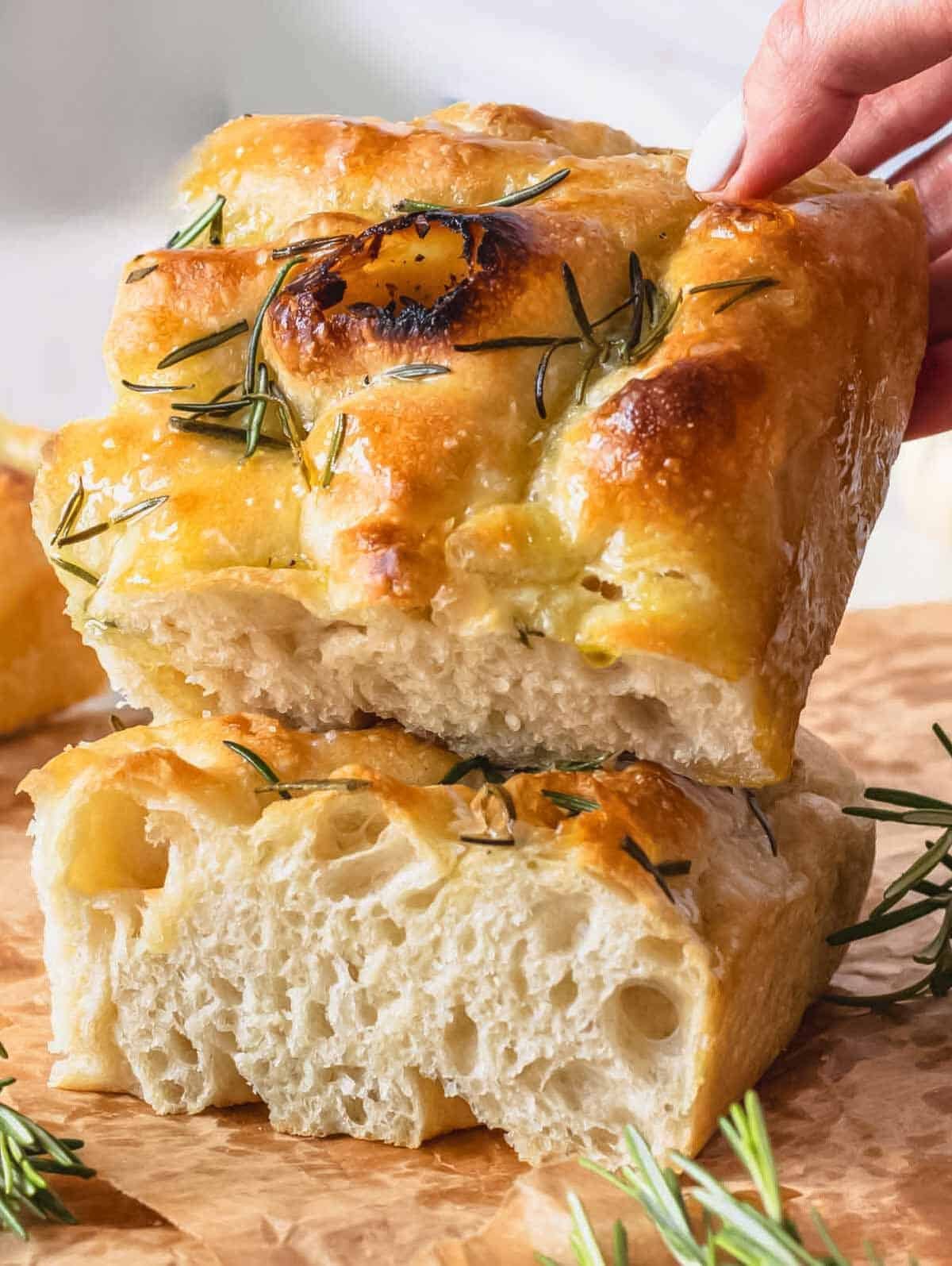
Table of Contents
Introduction
Where we are based, in central Italy, focaccia (pronounced FOKACCHA) is thin and crunchy, similar to schiacciata. In other regions, it is thicker and more similar to bread.
My love story with focaccia goes back decades. I remember well when, as a kid going to school, I would have a slice as a mid-morning snack.
10 AM sharp, all of us boys would put our wrapped slice of focaccia on the classroom’s radiator to reheat it. It was SO good! Can you imagine the smell in the classroom? The teachers were furious 😂.
Now, I passed on this love to Louise, who demands having a slice every Saturdays for breakfast from our favorite local baker, Nazzareno 🤷♀️.
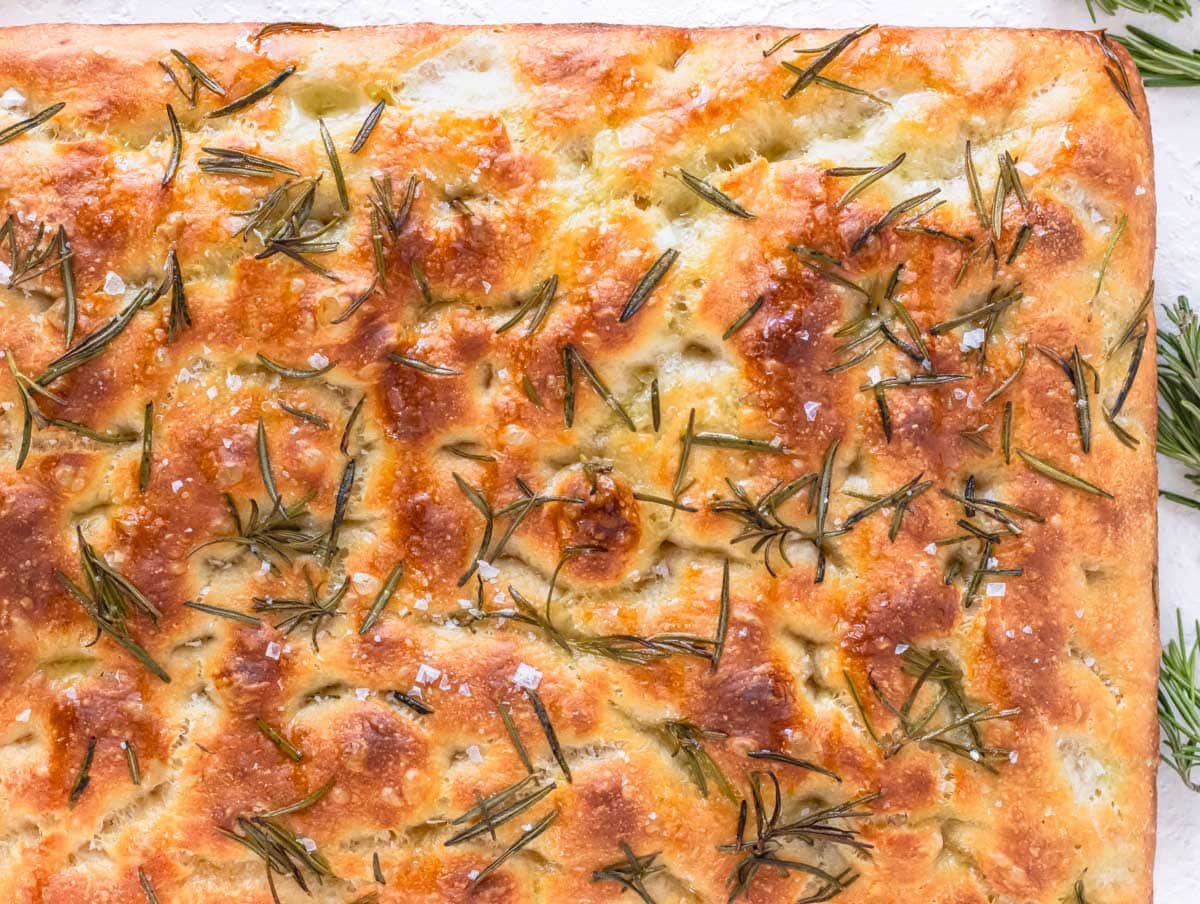
Just to be clear, focaccia in Italy is a high-quality product made with fresh ingredients, and it can be eaten whenever you want, from breakfast to dinner.
Every baker makes it every morning from scratch.
And I’ve studied many of those bakers, went to classes, and learned their top tips so that I could create this recipe for you 🤓.
An authentic Italian focaccia bread that’s easy to make at home with simple ingredients and without special ovens, equipment, or techniques.
Remember to save leftovers to make a delicious focaccia sandwich or Caprese sandwich.
And if you feel lucky or adventurous, you can even try making Neapolitan pizza or focaccia pizza.
Ingredients
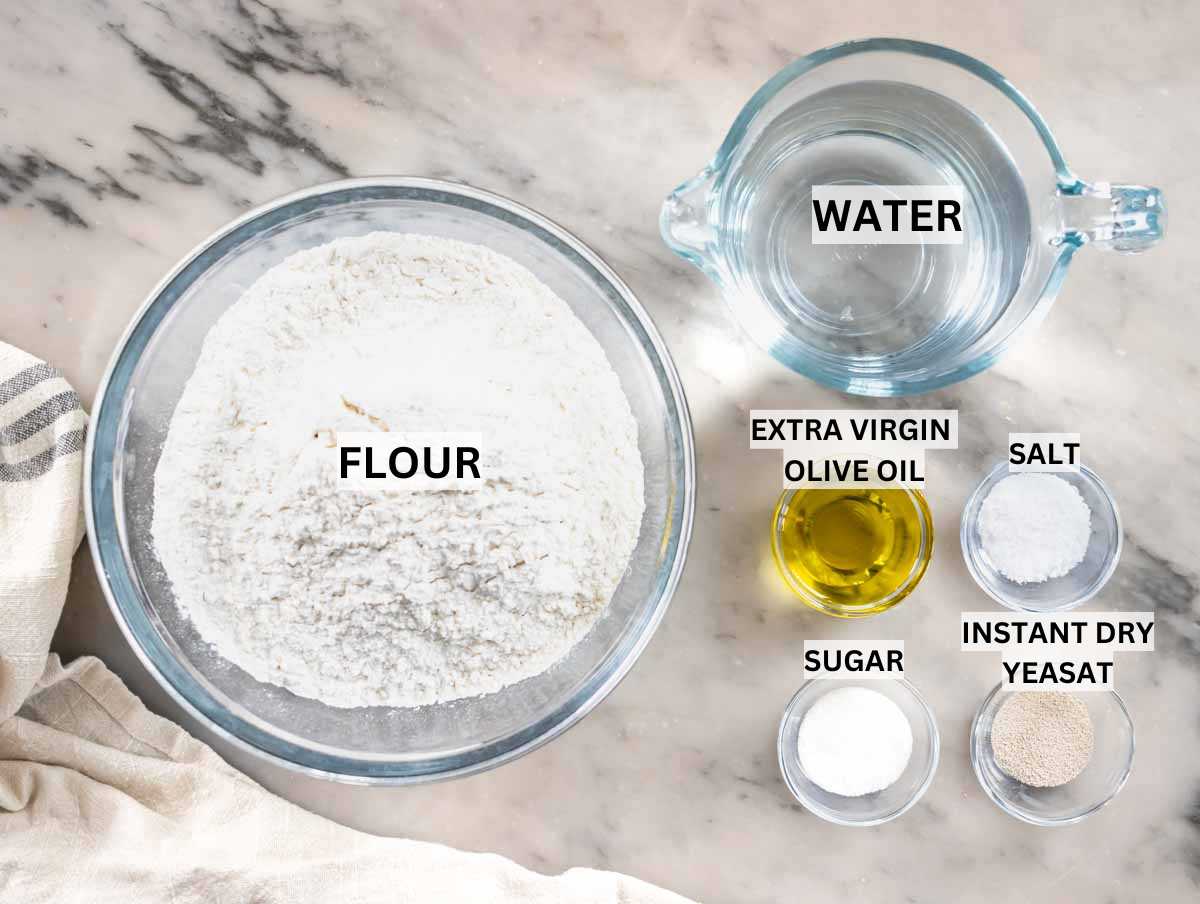
- Flour: bread flour or all-purpose flour. You can substitute half whole-wheat flour for half all-purpose flour. If you can find Caputo Pizzeria or Caputo Nuvola flour imported from Italy you are in for a treat (not sponsored).
- Water: lukewarm. Not hot, not cold.
- Yeast: we recommend instant dry yeast. Our favorites are SAF Instant and Caputo Dry Yeast (not sponsored). Other brands will work too. You can substitute fresh yeast for dry. In this case you’ll need 3X the amount compared to dry.
- Extra virgin olive oil: it gives flavor, softness, and prevents the focaccia from sticking to the pan. For less oil you can substitute parchment paper at the bottom (less flavor).
- Salt and sugar: salt for flavor, sugar for color and rise.
- Toppings: extra virgin olive oil, salt, water as a basic topping. Rosemary and flakey salt optional.
Important tips about baking pans
Focaccia will stick to the pan unless you use at least 2-3 tablespoons of olive oil or parchment paper to prevent sticking.
Pan options for different textures/thickness:
- 9×13-inch pan: Medium-thick focaccia, excellent for most occasions and great for focaccia sandwiches. It’s the one you see in the pictures and video.
- 13×18-inch sheet: Thinner, crispier focaccia, ideal for focaccia pizza.
- 8×8-inch pan: Thick, bready focaccia, perfect as a homemade bread substitute.
- 9×9-inch pan: Slightly thinner but still soft and fluffy.
- 10-11 inch round pan: Works well for making round focaccia.
How to make focaccia
Step 1: Bloom the yeast.
Measure ingredients first. Then add lukewarm water, instant dry yeast, and sugar to a small bowl, whisk and set aside for 30 seconds. Yeast must fully dissolve. If it doesn’t start again with fresh yeast.
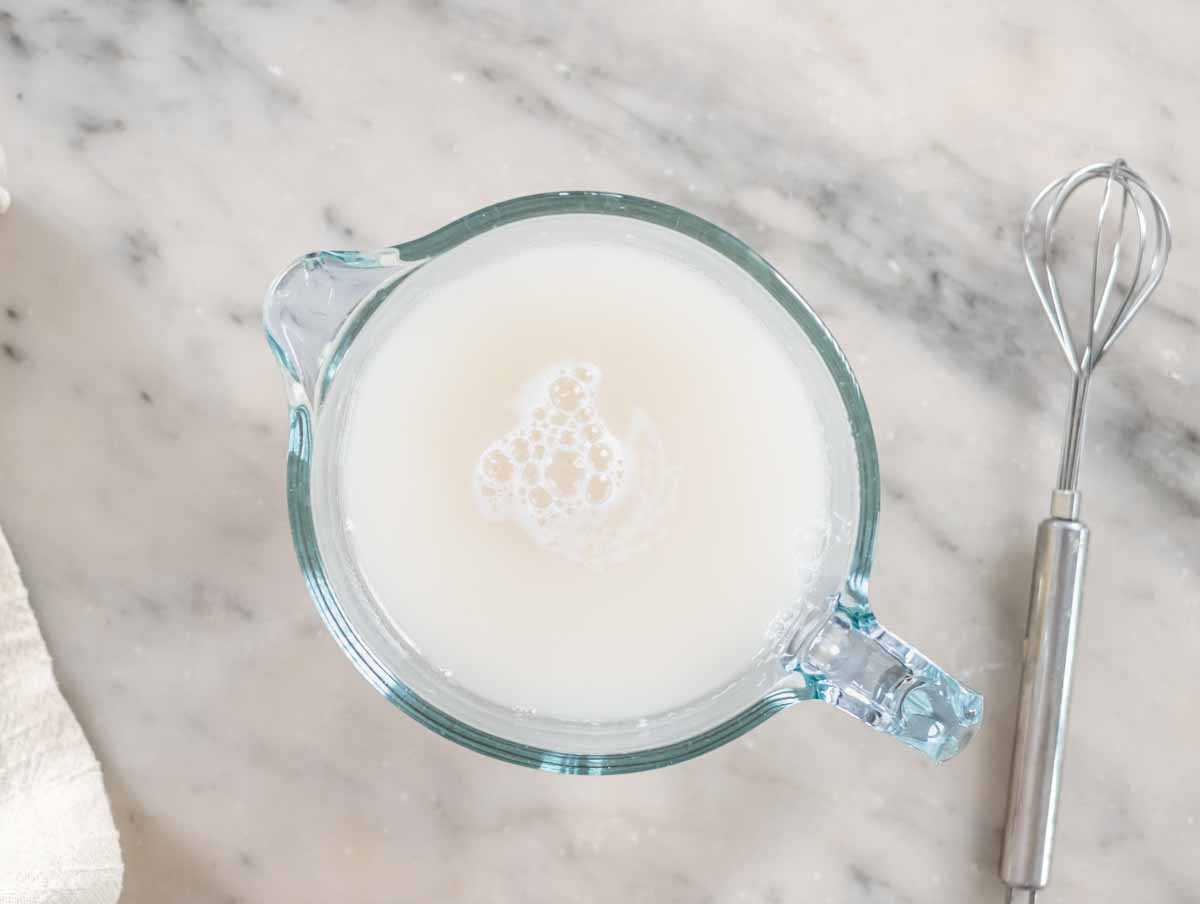
Step 2: Make the dough.
To a large mixing bowl, add and stir flour and salt. Now add the yeast-water mixture and stir with a sturdy wooden spoon until you have a wet, sticky dough (about 1 minute). Add extra virgin olive oil and stir one more minute until incorporated.
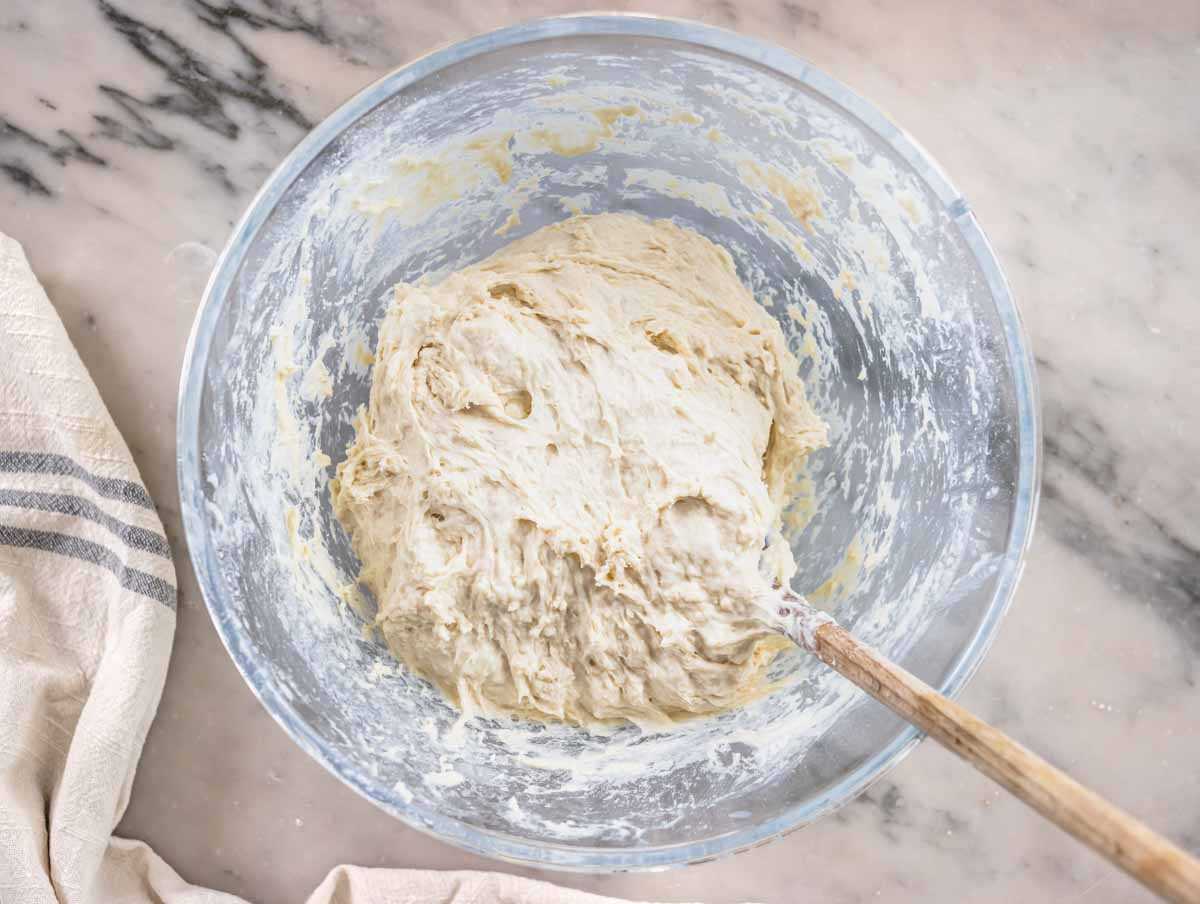
Step 3: Choose quick or slow proofing.
Quick proofing (1.5 to 2 hours): Cover the bowl with a damp cloth or plastic wrap, leaving enough space between the dough and the cloth.
Put the bowl in a slightly warm oven for 1.5 to 2 hours or until double in volume. To get the oven warm, turn it on for 60 seconds then turn it off. Don’t leave it on.
Slow proofing (8 to 24 hours): Cover the bowl with plastic wrap and let the dough mature slowly in the fridge for 8 to 24 hours.
When ready, remove from fridge and leave it at room temperature for 2 to 3 hours before the next step.
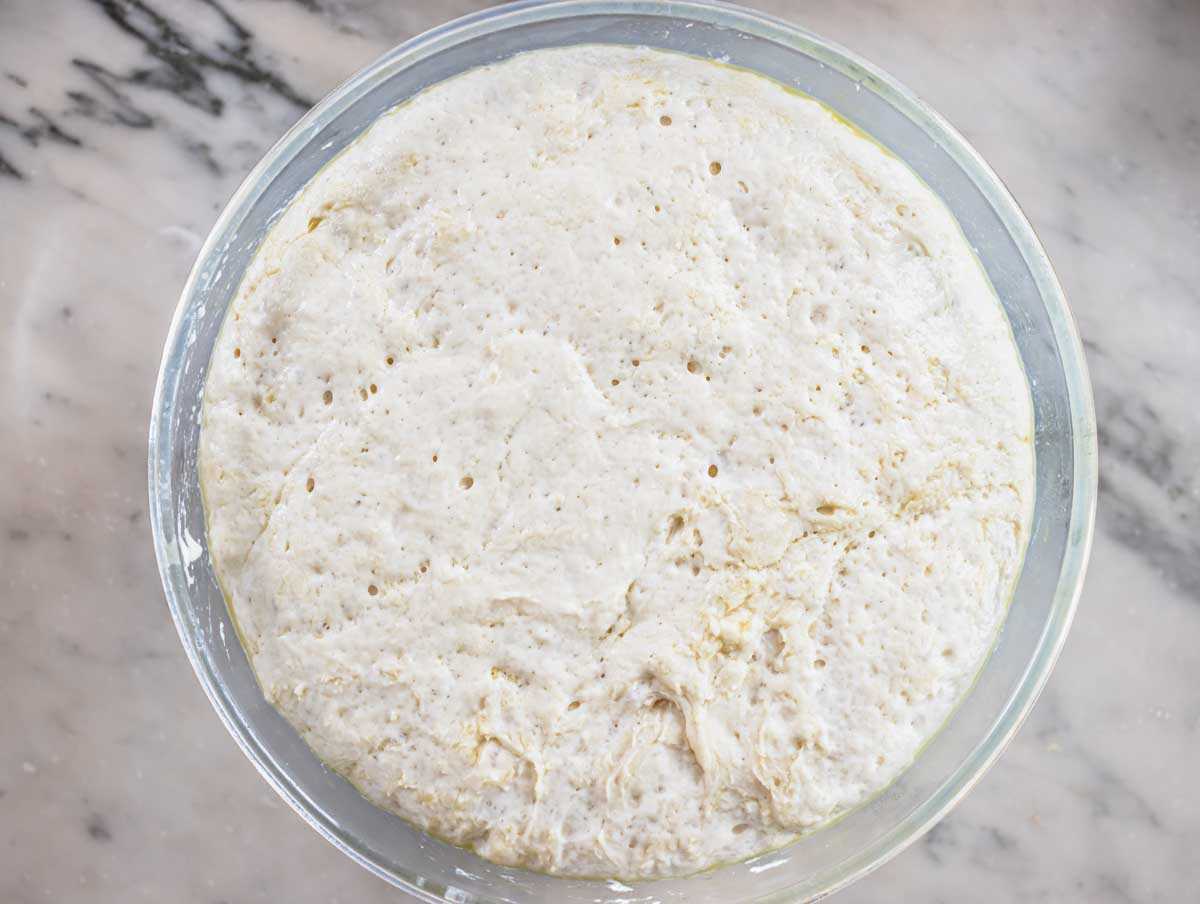
Step 4: Folding.
After proofing, fold the dough with a spoon over itself 20 to 40 times (it takes 30 – 60 seconds) from the outside to the inside while still in the bowl. Stop folding once the dough gets tight; you’ll feel it.
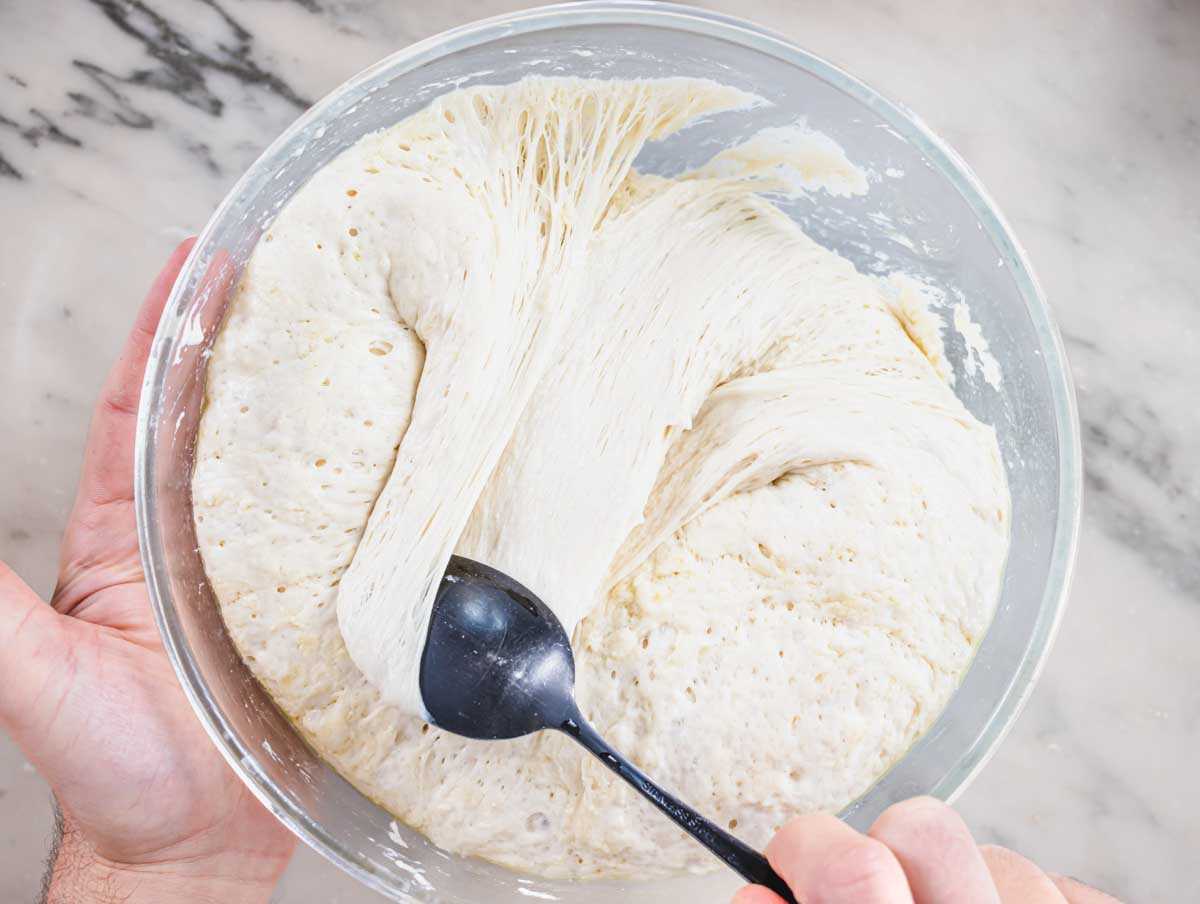
Step 5: Final proofing.
Grease your baking pan with 2 to 3 tablespoons of olive oil and drop the dough into the pan.
Spread the dough with the back of two spoons until most of the baking pan is covered.
Wet the spoons with water to prevent them from sticking. It’s okay if the focaccia gets a little wet on top.
Cover with a damp cloth/baking tray/or plastic wrap. Proof a second time in a warm corner of your kitchen for 45 minutes.
In the meantime, preheat the oven to 450°F or 230°C, and prepare the topping.
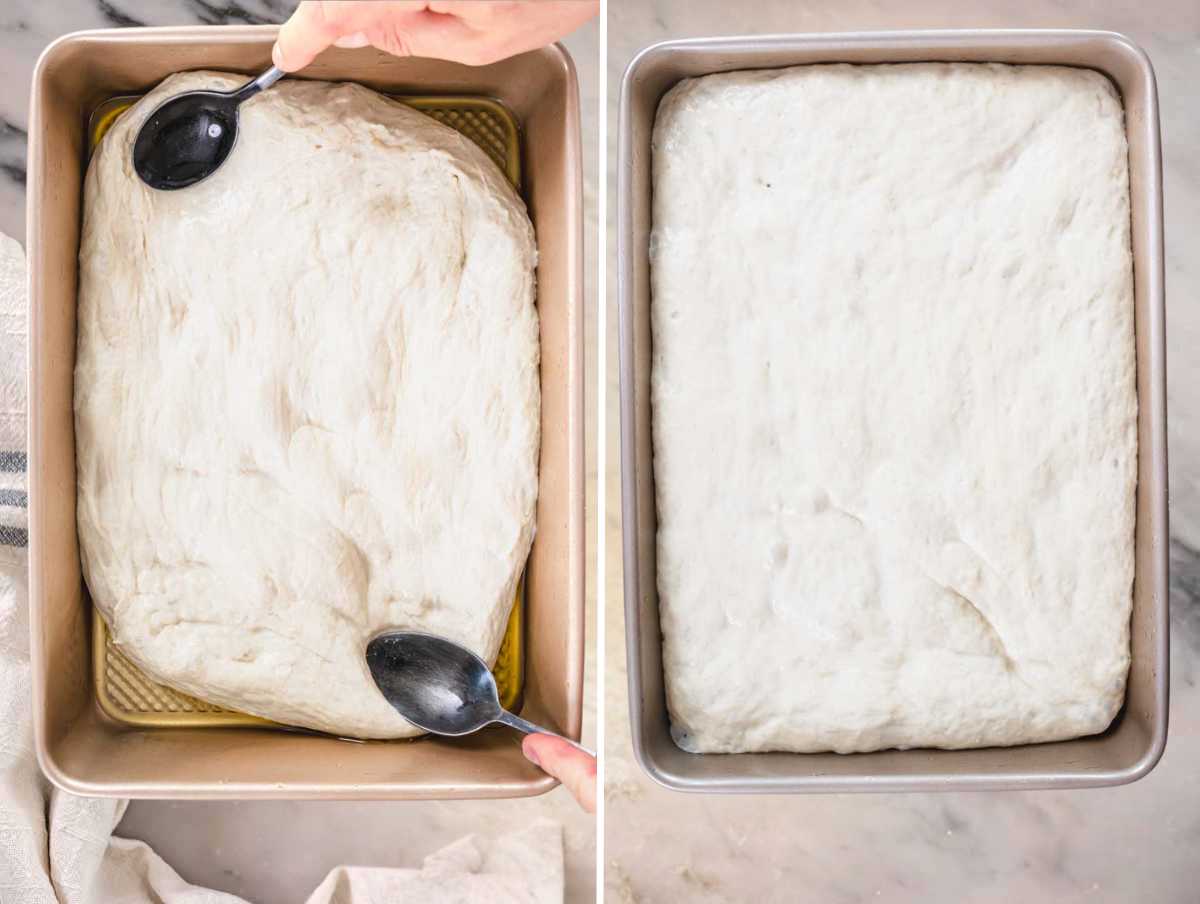
Step 6: Topping.
In a small bowl, mix olive oil, water and salt until dissolved. Dip fingers in it, then press dimples across the focaccia.
Pour the remaining oil-water mixture over the dough, letting it seep into the dimples.
Optionally, add rosemary and sprinkle with flaky or sea salt.
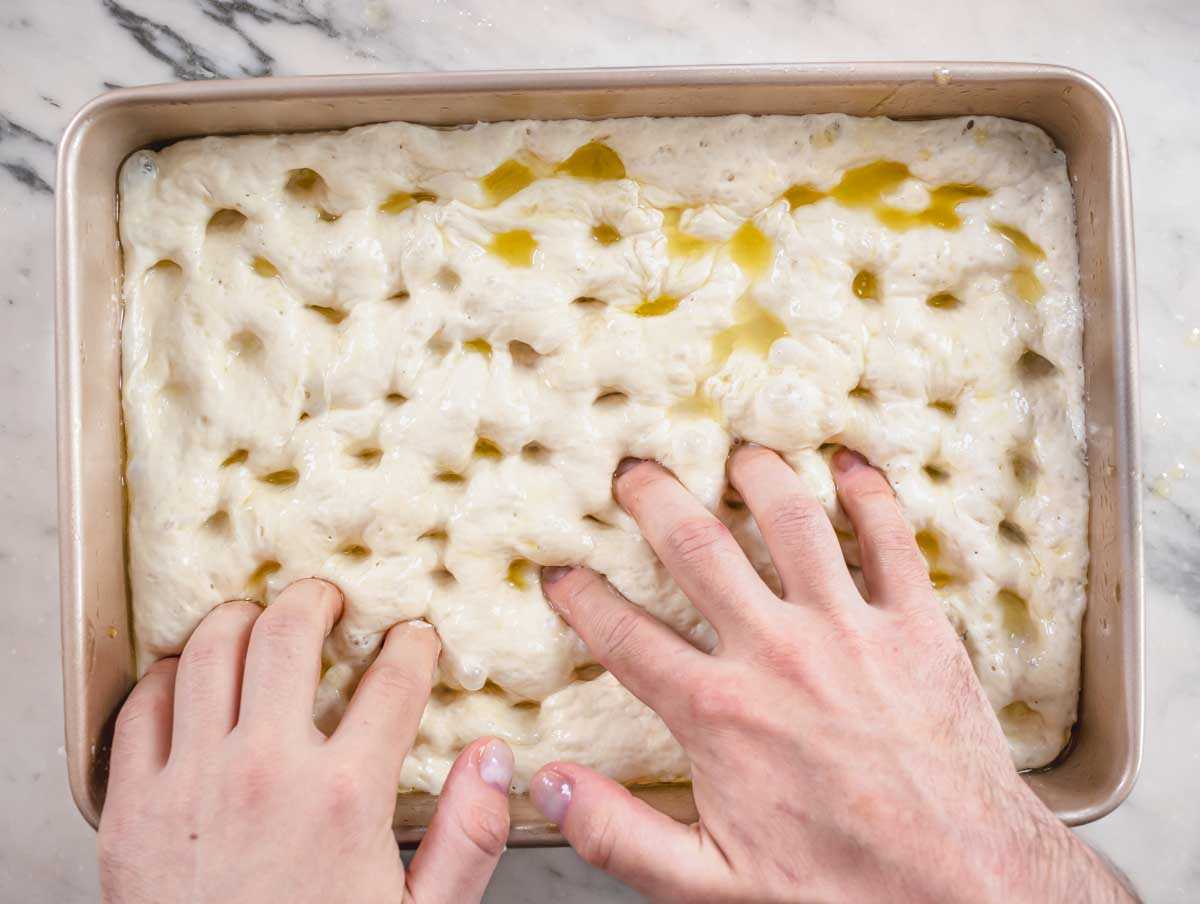
Step 7: Bake the focaccia.
When the oven reaches 450°F or 230°C, place the focaccia on the medium-low rack and bake it for 20 to 25 minutes.
Baking times vary. If your focaccia is thick, it’ll take closer to 25 minutes. If it’s thin, it’ll take closer to 20 minutes. It should be golden brown and crispy on top, well-cooked on the bottom, and still soft inside.
Let it cool down for at least 5 minutes before removing it from the pan, cutting it, and serving it.
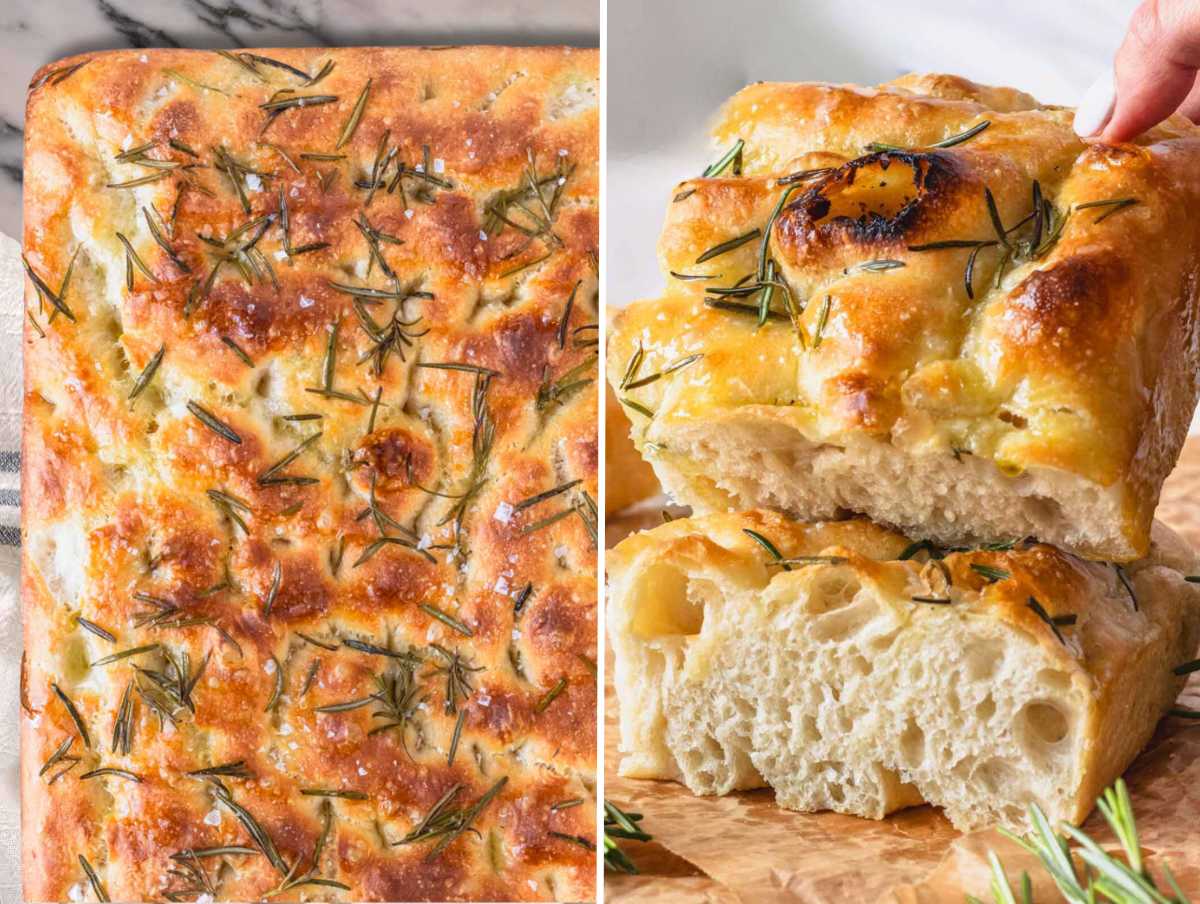
Variations
Our favorite variation is one with a topping of:
- 2 tablespoons olive oil
- 1 thinly sliced red onion
- 2 cups halved cherry tomatoes
- a heaping teaspoon of oregano
- 2 handfuls of olives, and salt.
Here’s the video on YouTube if you are interested.
But there are many more variations of focaccia. Each region has its own:
Pizza in teglia, Focaccia Genovese, Focaccia di Recco, Focaccia Barese, Pizza Bianca Romana, Focaccia alla Messinese, Schiacciata Toscana, Strazzata Lucana, Vastedda, Sfincione Palermitano, Sceblasti, Tiròt di Felonica, Chisola coi grasei, Pitta Calabrese, and more.
More bread & pizza recipes
- Flatbread pizza
- Tuscan schiacciata
- Homemade bread (easy no-knead recipe)
- Pita bread & Naan
- Piadina (Italian flatbread)
If you tried this Focaccia recipe or any other recipe on our blog, please leave a 🌟 star rating and let us know how it goes in the comments. We love hearing from you!
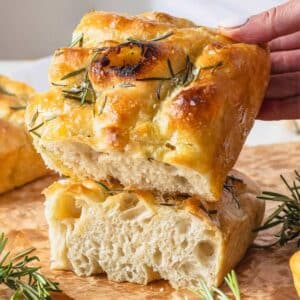
Focaccia
Equipment
- 9×13-Inch (23×33 cm) rectangular baking pan: See the notes below the recipe for more pan options.
Ingredients
FOR THE DOUGH
- 1¾ cups lukewarm water
- 2 teaspoons instant dry yeast
- 2 teaspoons sugar
- 4 cups all-purpose flour or bread flour
- 3 teaspoons salt
- 2 tablespoons extra virgin olive oil + 2 tablespoons to grease the baking pan or you can substitute parchment paper.
FOR THE TOPPING
- 2 tablespoons extra virgin olive oil
- 3 tablespoons water
- ½ teaspoon salt + flaky salt optional
- 3 pinches rosemary optional to taste; fresh or dry.
Instructions
- BLOOM THE YEAST: Measure ingredients for the dough.Then add lukewarm water, instant dry yeast, and sugar to a small bowl, whisk and set aside for 30 seconds.Yeast must fully dissolve. If it doesn’t, start again with fresh yeast.
- MAKE THE DOUGH: To a large mixing bowl, add and stir flour and salt. Now add the yeast-water mixture and stir with a sturdy wooden spoon until you have a wet, sticky dough (about 1 minute).Add extra virgin olive oil and stir one more minute until incorporated.
- Choose quick or slow proofing.QUICK PROOFING (1.5 to 2 hours): Cover the bowl with a damp cloth or plastic wrap, leaving enough space between the dough and the cloth.Put the bowl in a slightly warm oven for 1.5 to 2 hours or until double in volume. To get the oven warm, turn it on for 60 seconds then turn it off. Don’t leave it on.SLOW PROOFING (8 to 24 hours): Cover the bowl with plastic wrap and let the dough mature slowly in the fridge for 8 to 24 hours.When ready, remove from fridge and leave it at room temperature for 2 to 3 hours before the next step.
- FOLDING: After proofing, fold the dough with a spoon over itself 20 to 40 times (it takes 30 – 60 seconds) from the outside to the inside while still in the bowl.Stop folding once the dough gets tight; you’ll feel it.
- FINAL PROOFING: Grease your baking pan with 2 to 3 tablespoons of olive oil and drop the dough into the pan.Spread the dough with the back of two spoons until most of the baking pan is covered.Wet the spoons with water to prevent them from sticking. It’s okay if the focaccia gets a little wet on top.Cover with a damp cloth/baking tray/or plastic wrap. Proof a second time in a warm corner of your kitchen for 45 minutes.In the meantime, preheat the oven to 450°F or 230°C, and prepare the topping.
- TOPPING: In a small bowl, mix 2 tablespoons extra virgin olive oil, 3 tablespoons water and ½ teaspoon salt until dissolved.Dip fingers in it, then press dimples across the focaccia.Pour the remaining oil-water mixture over the dough, letting it seep into the dimples.Optionally, add 3 pinches rosemary and sprinkle with flaky salt.
- BAKE: When the oven reaches 450°F or 230°C, place the focaccia on the medium-low rack and bake it for 20 to 25 minutes.Baking times vary. If your focaccia is thick, it’ll take closer to 25 minutes. If it’s thin, it’ll take closer to 20 minutes. It should be golden brown and crispy on top, well-cooked on the bottom, and still soft inside.Let it cool down for at least 5 minutes before removing it from the pan, cutting it, and serving it.
Video
Notes
- 9×13-inch pan: Medium-thick focaccia, excellent for most occasions and great for focaccia sandwiches. It’s the one you see in the pictures and video.
- 13×18-inch sheet: Thinner, crispier focaccia, ideal for focaccia pizza.
- 8×8-inch pan: Thick, bready focaccia, perfect as a homemade bread substitute.
- 9×9-inch pan: Slightly thinner but still soft and fluffy.
- 10-11 inch round pan: Works well for making round focaccia.
- All-purpose flour: substitute bread flour, pizza flour, or use 50% all-purpose and 50% whole-wheat flour. If you can find Caputo Pizzeria or Caputo Nuvola flour imported from Italy you are in for a treat (not sponsored).
- Instant dry yeast: we recommend Caputo Dry Yeast, sold in a small green can, Red Star SAF instant, and Dr. Oetker instant yeast (not sponsored). You can substitute fresh yeast for dry yeast. You’ll need three times more fresh yeast than dry yeast.
- Make ahead: Best enjoyed fresh, but the dough can be refrigerated for slow proofing.
- Room temperature storage: Keep leftovers in an airtight container for up to 2 days (not in the fridge).
- Freeze: Cool completely, cut into squares, and freeze for up to 3 months.
- Thaw & Reheat: Defrost at room temperature or in the microwave, then reheat in the oven (10 min at 360°F/180°C) or air fryer (5 min).
Nutrition
Thinking of making pizza next? Here are some recipes to start:
Breads
Quick Pizza Dough
Breads
Neapolitan Pizza Dough
Breads
Pizza Dough Recipe
Breads

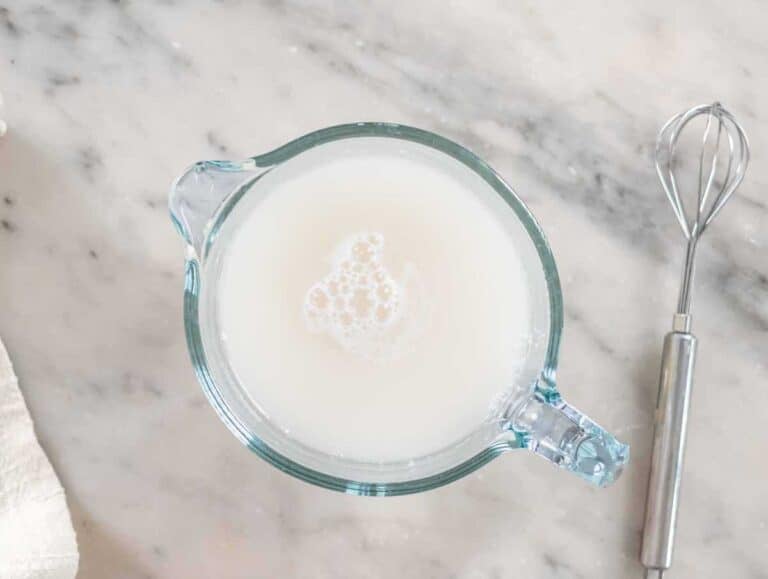
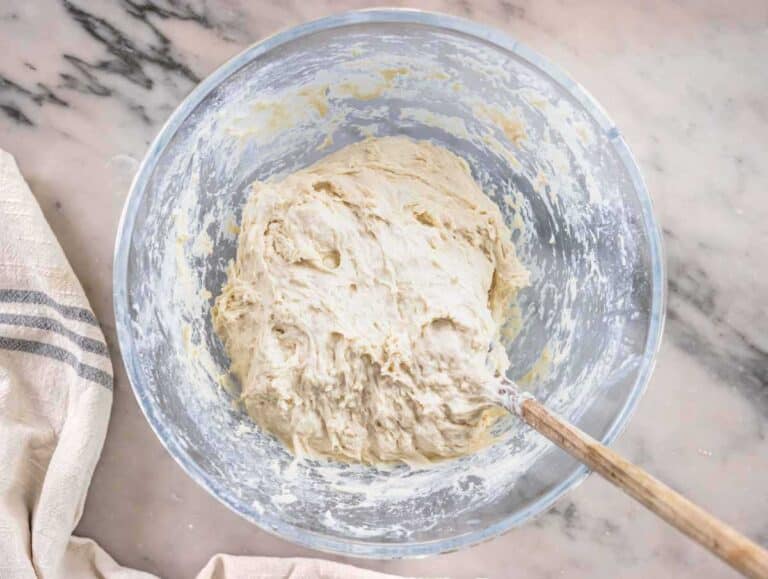
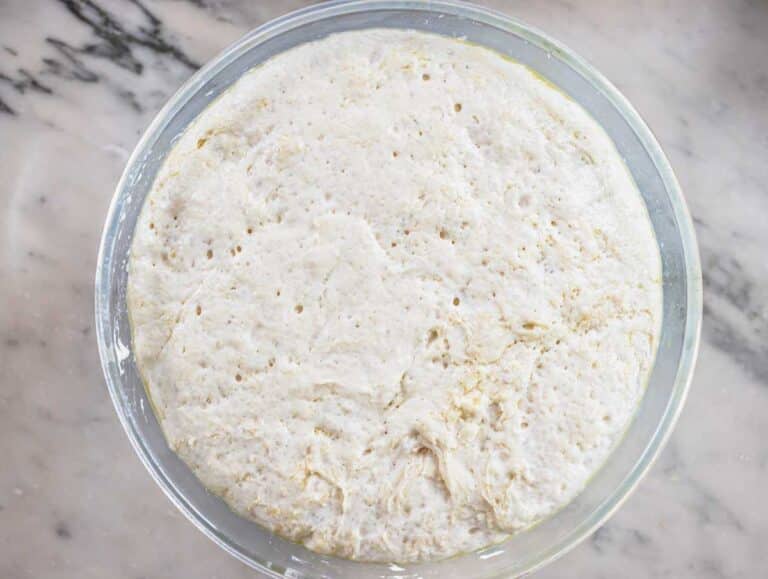
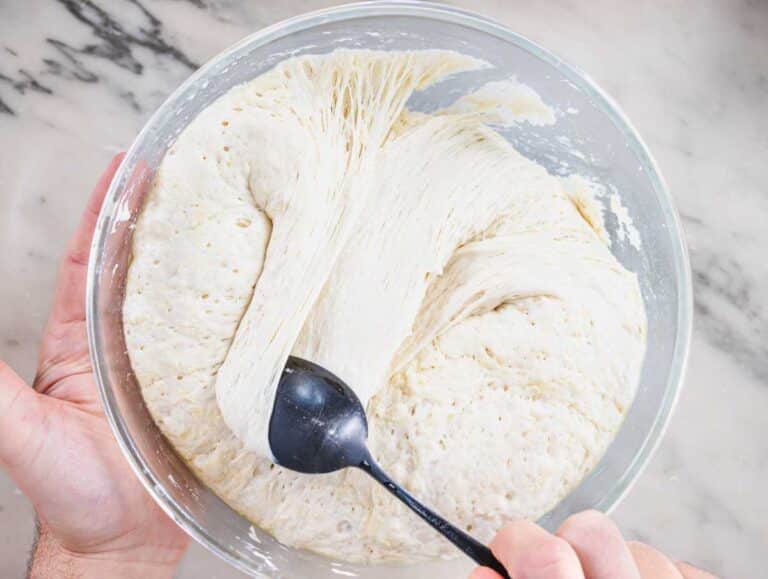
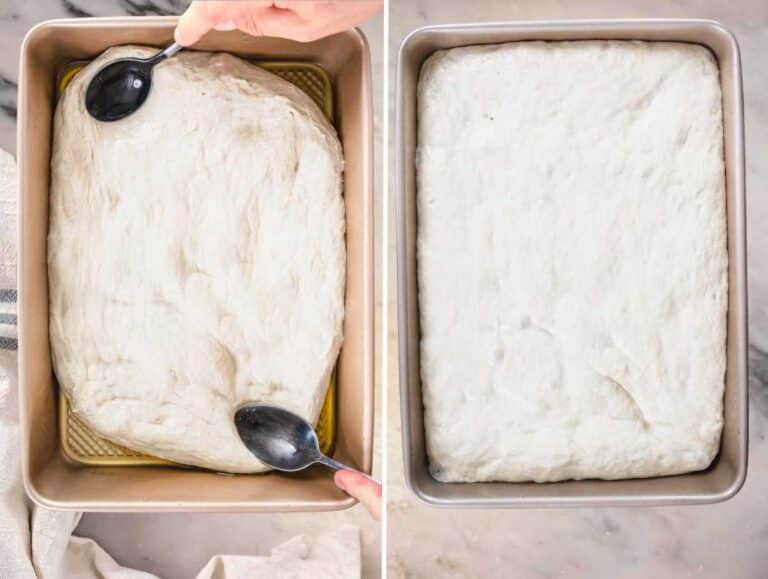
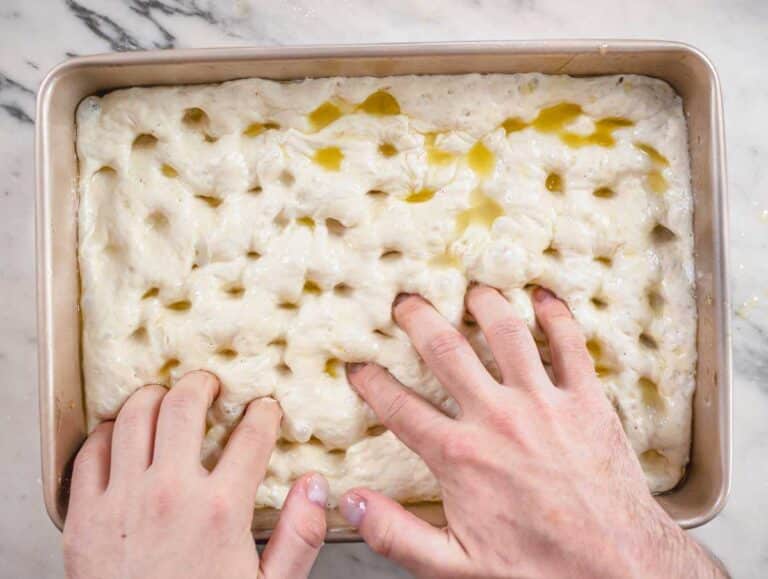
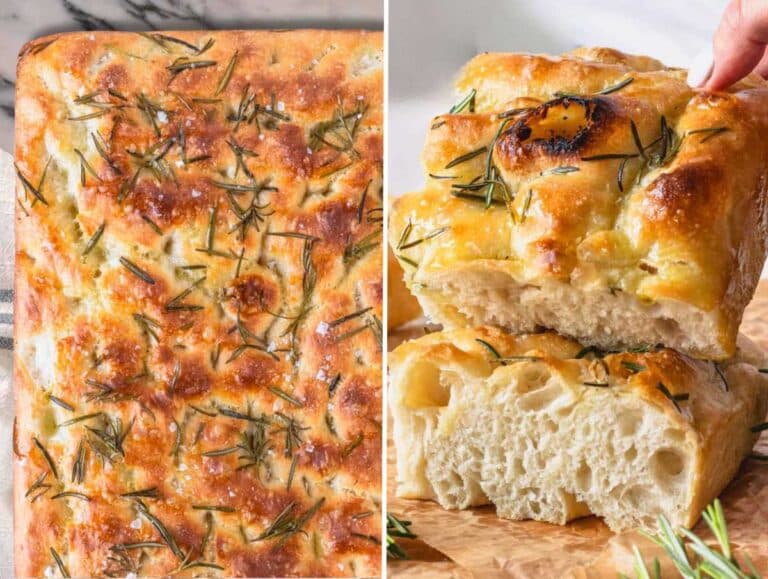


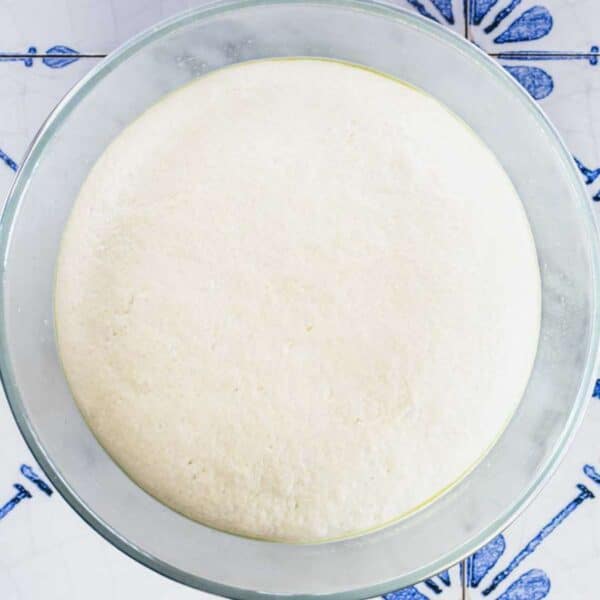
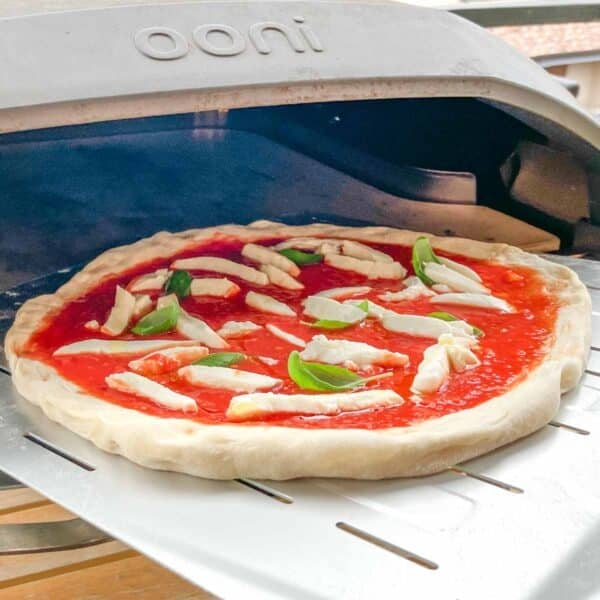

AMAZING!!!!!!!!!!!!!!!!!!! I let it rise overnight in the fridge, and added sea salt and rosemary before baking. It was so golden, fluffy, spongy (like focaccia should be!) and crispy on the edges!!! There is a perfect balance of crispiness from the crust and soft fluffy inside. My family loved it! Will def be keeping this recipe tysm!
Hi Amber,
Thank you so much for the amazing feedback — I could practically smell your focaccia through the screen! Sea salt and rosemary are perfect finishing touches, and I’m thrilled to hear your family loved it.
Kindest,
Louise
Just perfect! I’ve done it numerious times before writing this review 😊
Hi Milda,
Thank you! That means so much — especially knowing you’ve made it numerous times. All the best,
Louise
Hi Nico,
I’ve made your focaccia recipe several times – I’m wondering if the step of folding it 20 times is super necessary, as I find the focaccia is good – but doesn’t give me those massive air bubbles I’m looking for 🙂
Today I’m doing the overnight proofing, but I’ve also done the quick proof method as well (I’ve made your recipe dozens of times) — I’m not sure how else I can improve results, as I’ve reviewed all the notes.
I find it rises really well but then when I move it to the pan 45 minutes is maybe not enough time for me to get it to rise as much as I would like — would love your input!
Hi Lianne,
Replying on behalf of Nico as he is in the kitchen testing a pasta recipe 😛.
Thank you for your thoughtful message and for making the recipe so many times — that truly means a lot! You can definitely experiment with fewer folds if the dough is rising well; the folding is mainly for structure, not air bubbles.
For bigger bubbles, try giving it a slightly longer second rise after moving it to the pan (up to 1.5–2 hours if your kitchen is cool), and handle the dough as gently as possible during that transfer. Let me know how it goes — I’d love to hear your results!
Let me know if you have any other questions.
Happy baking,
Louise
Loved it
If I was to make 10 at once, would I divide the dough before or after the first proofing? Thanks.
Hi Danii, wow that sounds like you are making focaccia for a bunch 😉 It would be best to divide the dough before proofing. You want touch the dough as little as possible once it has proofed. Happy baking!
Kindest, Louise
Easy and delicious